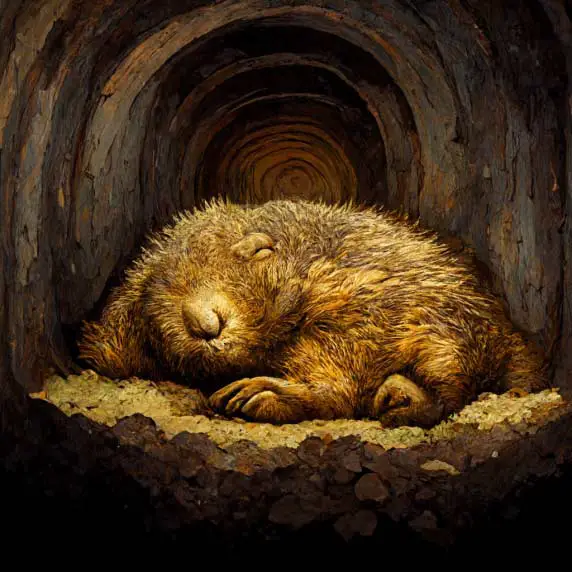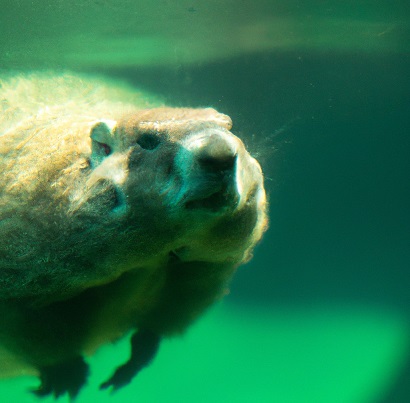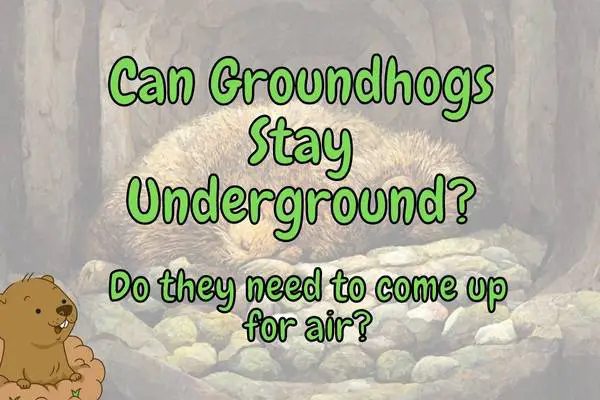Groundhogs, also known as woodchucks, are burrowing rodents that spend a large majority of their lives underground. Groundhogs are native to North America and can be found in the eastern and central United States as well as parts of Canada.
Groundhogs spend most of their time underground, but they do come up multiple times a day unless threatened or hibernating.
Groundhogs can, in theory, stay underground for weeks on end as they dig ventilation shafts for fresh air and extra chambers for food storage. So the time they can stay underground depends on how much food they have available and how much it rains. When they hibernate they stay underground for months without coming up for food or fresh air!
Groundhogs, like gophers and moles, are rodents that have evolved to live mostly underground.
They use their sharp claws and teeth to dig extensive tunnel systems in the ground, and they are very efficient at it! A single groundhog can dig a tunnel that is up to 18 feet long in just one night.
If a groundhog tunnel becomes too long or complex, it can create pockets of stale air where carbon dioxide can build up and pose a health hazard for the animals.
To prevent this, groundhogs will create side tunnels leading to the surface which act as ventilation shafts. These shafts allow fresh air to enter the system and keep the levels of carbon dioxide low enough for the groundhogs to safely breathe.

In fact, they only need to come up to the surface now and then to forage, defecate, and get some fresh water. When they are above ground, they are usually only out for a few minutes before scurrying back down into their tunnels. But this depends on the area and time of year!
Since groundhogs also eat animals, like the worms they find while digging their tunnels, they do not necessarily need to come up for food. They can also easily eat the roots of plants and trees while still underground.
If they choose to stay underground to find their food, they will mostly eat roots, grubs and worms.
Contents
How can Groundhogs Breathe Underground?
Groundhogs can breathe while underground in their tunnels, because the tunnels are not closed and fully airtight. The tunnels of groundhogs do have, sometimes multiple, exists that allows air to enter.
Just like any other mammal, groundhogs have lungs that extract oxygen from the air. The main difference is that because they spend so much time underground, they need to be extra careful about ensuring that their burrows have adequate ventilation.
Groundhogs mostly breathe through their noses and they have no problem with the smell of soil apparently! They can easily breathe for multiple days underground, and when they hibernate, they spend months without coming out for fresh air!
Do Groundhogs Need to Come up for Air?
Not necessarily, groundhogs can stay in the burrows for days without coming out. Groundhogs, like moles and gophers dig a sophisticated tunnel system with different surface channels to facilitate airflow.

However, because they do like fresh air and food and they do not like to defecate and pee in their tunnels, so they usually come out a few times a day unless they are hibernating.
Also, if there has been heavy rainfall, groundhogs will be more likely to come up for air because their tunnels can get flooded. They are pretty good at digging drainage shafts to avoid flooding of their tunnels, and they tend to dig their burrows in well-drained soil.
Why do Groundhogs Stay Underground?
There are a number of reasons why a groundhog might stay underground in its tunnels. Predators, cold weather, and hibernation are all possible explanations.
Groundhogs dig tunnels for shelter and to find food below the surface. Groundhogs are omnivores but eat mostly plants but also their roots.
Groundhogs can eat roots and insects while staying underground in their tunnels although they do prefer to come out when feeding.
Do Groundhogs Sleep Underground?
Yes! Groundhogs sleep in a burrow system, which is a tunnel in the ground. They usually dig their burrow tunnels to keep themselves and their food away from predators. A groundhog burrow system can be anywhere from 5 to 100 feet long.
Groundhogs usually sleep near the exit, so that they can get fresh air and are ready to escape if a predator should enter.
How Do I Prevent Groundhogs From Digging In My Yard?
There are several things that can be done to prevent groundhogs from digging in your backyard. I will list some of the strategies below.
Also, see my recent post if you want a full list of my favorite methods to keep groundhogs and gophers away!
1. Using ultrasonic sound
Groundhogs, like other bigger animals that may invade your garden, tend to have very good hearing. This means that loud or consistent noises will scare them away or at least shorten their visits.
One of my favorite technologies to keep pests away from my backyard is these cool solar-powered ultrasonic sound emitters that you can buy right off Amazon! In my experience, they really work, and the solar panels on top save you the time and money of changing batteries all the time.
They will also work against other rodents like gophers, mice, and rats!
2. Sprinkling natural repellents
Groundhogs may be scared off by using natural scents such as coyote urine or predator scents.
They may also cause them to leave if there is a combination of sounds being played from a radio. The sounds include the sound of barking dogs and coyotes.
You can sprinkle dog hair, cayenne pepper or strong enteric oils and other natural repellents around the garden to keep the groundhogs away.
See my complete list of humane ways to keep groundhogs away from your yard for more tips and tricks!
3. Fencing around the garden
You can also fence around your garden to keep groundhogs from entering the garden. It should be at least 3 feet deep and have a double row of fencing.
Groundhogs are good diggers so it has to go underground or they may find a way into the garden even with the fences in place!
4. Using live traps
You can use a live trap to capture groundhogs and move them to another area. Live trapping is currently the most humane way of groundhog control. Once you have removed all groundhogs from an area, it is important to ensure that they do not come back by using fencing or other barriers to block access.
You can also just buy a live trap, as the sturdy metal ones shown here:
5. Using pesticides
There are pesticides or rodent toxins that can be used to kill groundhogs on your property. These may also affect other animals in the area so it is important to ensure that they are only sprayed on the targeted plants. I do not recommend these, as I prefer more humane ways as described here.
6. Using Scarecrows
You can use a scarecrow in your garden to keep groundhogs away. Groundhogs are afraid of novelty so time-sensitive or motion-activated scarecrows may also be effective in keeping them out of the garden.
7. Using Lights
Groundhogs are nocturnal animals so they may avoid areas that have bright lights. Motion-activated lights, sounds, and sprinklers may help prevent groundhogs from entering your yard.
8. Motion-activated sprinklers
Like most animals, groundhogs hate surprises, and they will run away if suddenly sprayed with water. I like this solution because it is humane, simple, effective, and does not require much time to set up.
The Havahart 5277 is a motion-activated sprinkler that is activated by the movement of animals up to 25 feet away and sprays them with a harmless water jet, frightening them off and keeping them at bay.
The included metal stake makes it easy to install in your garden, and the sprinkler can be rotated 180 degrees for maximum coverage.
What about water?
I have already written an article about groundhogs relationship with swimming in water, but here is a short summary as it realtes to their lifes underground as well!
How long can a groundhog stay underwater?
On average, a groundhog can hold its breath for 2 to 5 minutes but they are not naturally inclined to do so – unless they go swimming!
Groundhogs can in fact swim just as their closely related cousins the gophers also sometimes enjoy a good swim in a small stream or lake. In such an event, they may hold their breath for quite some time, but most groundhogs do not ever need to do so.
They do not need to hold their breath because their tunnels rarely fill with water due to the way they are designed with drainage and because the groundhog would leave the tunnel in time to avoid drowning.
Do groundhogs like water?
No, groundhogs associate water with flooding their tunnels so they do not like to be submerged in water. However, they are not very afraid of rain or puddles.
Groundhogs will not go into the water unless absolutely necessary, but their cousins, the gophers, are sometimes seen swimming around in streams and ponds.
Can Groundhogs Breathe Underwater?
No, they have lungs and not gills like fish. But they may be able to stay underwater for up to five minutes.

No mammals can actually breathe underwater and even whales need to come up for air occasionally! Only some sea creatures like crabs can actually breathe below and above water!
Conclusion
In conclusion, groundhogs are burrowing rodents that spend a large majority of their lives underground. They are native to North America and can be found in the eastern and central United States as well as parts of Canada.
Groundhogs can stay underground for weeks on end and only come up for food or water. When they hibernate, groundhogs can stay underground for months without coming up for fresh air!
There are many humane ways to keep them away if you wish to do so as they can sometimes make a mess and eat all your vegetables among other things.















